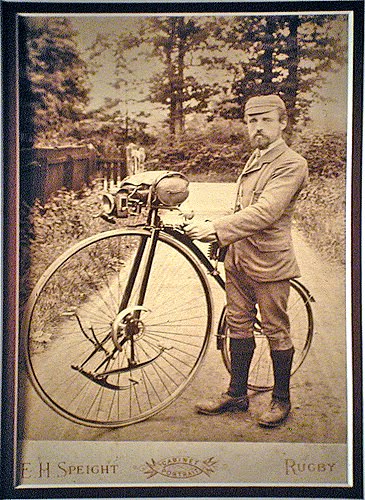Cleaned up silver soldered joints, the head will be plated later
and these require a little more work.
The depth is not super critical but I didn't want to
break through the tube wall so I had to be careful here.
The brazed joints all cleaned up easily but doing so showed up a slight movement in the non gear side bearing housing. This has clearly happened as a result of the heat, the housing are now not quite parallel. The discrepancy is very slight and doesn't seem to affect the bearing (I built it up to check) which is good because the chances of cold setting the 4130 forks is effectively nil, they are very strong.
I also drilled and tapped the holes for the oiler and inner bearing race locking grub screw (2BA & 4BA respectively). On the original these holes were very close. too close I thought so I cross referenced with some pictures I took of the racer in the Coventry Transport Museum. This famous machine has the oiler hole located much higher up and away from the grub screw, I have done the same and based mine upon the Percy Nix bike in Coventry.
The original facile I am copying has very close
holes for the oiler and inner race grub screw.
The holes on Percy Nix's racing machine are farther apart.
I've based mine upon the Coventry machine.
A good view of the grub screw and the oiler in place.
The Coventry bike is missing it's oilers, this oiler is missing it's cover.
They're tricky little things, the inner edge is a curved 45 degree bevel
and then two notched are filed into this to produce three teeth
to lock into the castellations on the outer bearing race.
My stock of 4BA cheese head screws is a little low,
hence the rusty one used in the picture.
BA screws are all but unobtainable for sensible money in NZ
so I'll either make or import some myself.
Next week I'll hack into a large chunk of Gunmetal (LG2 bronze) and start the spoke flanges for both wheels. Gunmetal machines beautifully so I'm really looking forward to this.
In other news my parents, both keen gardeners, have been busy in our garden. When we moved in many years ago we found an old greenhouse hidden in one corner of the garden. My parents have now dismantled this to allow us to move the compost bin to somewhere where it may actually work. My father has about a dozen greenhouses himself but I'm unsure how he's going to fit mine into his suitcase when he leaves. I'm sure he'll try.
An amusing incident happened at dinner the other night, the children were running through all the languages that they knew how to say hello in. After the obvious English, French, German, Spanish, Maori & Japanese, my daughter upped the ante with Gaelic. "Pogue Mahone" she proudly said. I nearly spat my tea all over the table, having shared a house with a native Gaelic speaker at University I happened to know what this very useful phrase actually means. I suspect that an unknown Irishman has been having a little fun at the expense of my Daughters teacher. Apparently the class all solemnly repeat the phrase in that special monotone that children the world over reserve for "Good Morning Teacher". My daughter was very embarrassed when I told her what it meant, whilst my son was busy writing it down. My parents were not amused in that very Victorian manner.









No comments:
Post a Comment